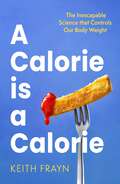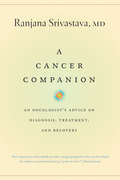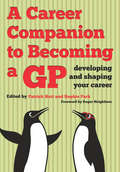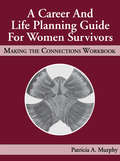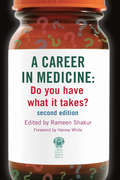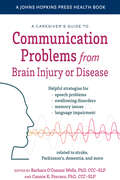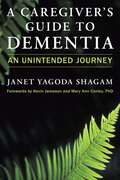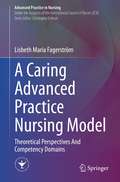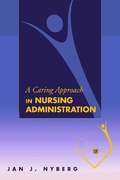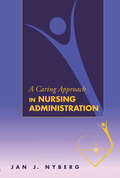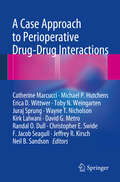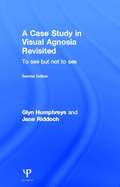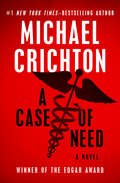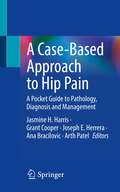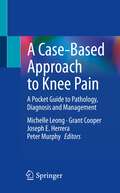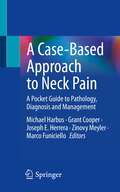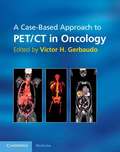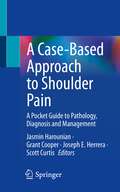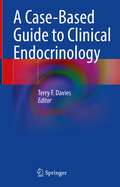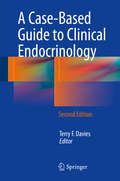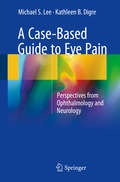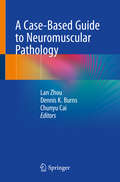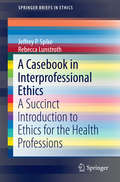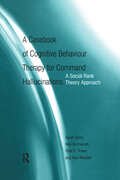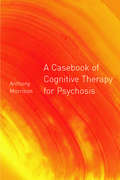- Table View
- List View
A Calorie is a Calorie: The Inescapable Science that Controls Our Body Weight
by Keith FraynWe all know someone who seems to eat very little yet cannot avoid weight gain, or someone who eats everything they like while remaining slim. Why? Is it the kinds of food we eat, and when? Are our hormones to blame? Could it be chemicals in our environment? Even specialists are now questioning our understanding of the forces that shape body weight, and we are all more confused than ever.In this book, Keith Frayn, one of the world's leading experts on metabolism, argues that all these challenges are distracting us from tackling the obesity problem in the only way it can be addressed: by rebalancing the disregarded message of 'calories in - calories out'.Taking readers on a deep dive into the real science of energy balance, he reveals how nutrition research has been plagued by the difficulty of really knowing what people are eating and doing; why it is unlikely that some nutrients are intrinsically more fattening than others; how supposed differences between people in the speed of their metabolism vanish in the laboratory; how energy balance is altered in obese people and people who have managed to lose weight; and why these responses - honed over millennia of evolution - make dieting so hard. With clarity and insights from expert research, Frayn provides a clear-eyed perspective on current trends mired in controversy and confusion: time-restricted eating, intermittent fasting, low-carb versus low-fat meal plans, high-protein breakfasts and other dietary trickery. In a world where desirable, energy-rich food is increasingly plentiful, and labour-saving gadgets widespread, it becomes more and more difficult to stick to the simple message of energy balance. But, as Frayn shows, we can reshape our lives and improve our health by going back to what we know about calories, rediscovering the benefits of a more active life, and getting smart about what we eat.
A Cancer Companion: An Oncologist's Advice on Diagnosis, Treatment, and Recovery
by Dr Ranjana SrivastavaCancer. It's the diagnosis no one wants to hear. Unfortunately though, these days most of us have known or will know someone who receives it. But what's next? With the diagnosis comes not only fear and uncertainty, but numerous questions, as well as, often, a lot of unsolicited advice. With "A Cancer Companion," esteemed oncologist Ranjana Srivastava is here to help, bringing both experience and honesty to guide cancer patients and their families through this labyrinth of questions and treatments. With candor and compassion, Srivastava provides an approachable and authoritative reference. She begins with the big questions, like what cancer actually is, and she moves on to offer very practical advice on how to find an oncologist, what to expect during and after treatments, and how to manage pain, diet, and exercise. She discusses in detail the different therapies for cancers and why some cancers are inoperable, and she skillfully addresses the emotional toll of the disease. She speaks clearly and directly to cancer patients, caretakers, and their loved ones, offering straightforward information and insight, something that many oncologists can't always convey in the office. Equipping readers with the knowledge to make informed decisions at every step of the way, "A Cancer Companion" is an indispensable guide by a physician who cares to educate patients as much as she does to treat them.
A Career Companion to Becoming a GP: Developing and Shaping Your Career
by Patrick Hutt Sophie Park'How many general practitioners ended up in their roles thanks to a faint breeze nudging them in a given direction? How many successes resulted from failure? Some of the most successful practices were built up from nothing, and some of the happiest doctors spent time not being doctors. Despite the element that fate plays in career paths it is prudent to make plans - ' A career in general practice offers many options for further professional development. While some GPs prefer to concentrate primarily on their practice, others find additional fulfillment in teaching, research or international collaboration. Whichever path you choose, general practice promises a rewarding and exciting experience. This inspiring new book emphasises there is no single career path in general practice. Without being prescriptive, its practical approach helps you make life-changing decisions, prompts self-analysis and equips you with the tools to remain flexible, positive and reflective about your career. 'So - have you got what it takes to practise the 'medicine plus' which is today's general practice? This book, written and edited by colleagues many of whom have far more street cred than I, will help you decide. If you have, I wish you luck, fulfilment, and the gratification that comes from being a catalyst for good in the lives of your fellow human beings. If you have a role teaching and mentoring the next generation of GPs, you will find this book a persuasive ally. But if you decide that hospital medicine is your preferred option - well, that's fine. There would be no shame, if you find the ladder to general practice too steep, in settling for becoming a brain surgeon.' Roger Neighbour, in the Foreword 'Lively, extremely informative and engaging' Professor Roger Jones, Editor, British Journal of General Practice
A Career and Life Planning Guide for Women Survivors: MAKING THE CONNECTIONS WORKBOOK
by Patricia MurphyThis book aims to assist women survivors of abuse in creating and directing their own vocational plans whether or not these efforts take place in state departments of rehabilitation and work and welfare programs such as the JOBS program arising out of the Family Services Act.
A Career in Medicine: Do you have what it takes? second edition
by Rameen ShakurHave you ever thought about becoming a doctor but weren't sure where to start or what to expect? This book provides a comprehensive resource to guide you through the various stages involved in becoming a doctor, from deciding whether medicine is right for you, to choosing and applying to medical school, interview skills, student finance, plus what
A Caregiver's Guide to Communication Problems from Brain Injury or Disease (A Johns Hopkins Press Health Book)
by Barbara O’Connor Wells, PhD, CCC-SLP and Connie K. Porcaro, PhD, CCC-SLPAn all-in-one guide for helping caregivers of individuals with brain injury or degenerative disease to address speech, language, voice, memory, and swallowing impairment and to distinguish these problem areas from healthy aging.Advances in science mean that people are more likely to survive a stroke or live for many years after being diagnosed with a degenerative disease such as Parkinson's. But the communication deficits that often accompany a brain injury or chronic neurologic condition—including problems with speech, language, voice, memory, and/or swallowing—can severely impact quality of life.If you are a caregiver coping with these challenges, this all-in-one book can help you and your loved one. Written by a team of experts in speech-language pathology, each chapter focuses on a different aspect of caregiving and features relatable patient examples. Providing answers to common questions, definitions of complex medical terms, and lists of helpful resources, this book also:• touches on expected, age-related changes in communication, memory, swallowing, and hearing abilities, to name a few• offers practical strategies for caregivers to cope with speech, language, and voice problems and to maximize their loved one's ability to communicate• reveals how caregivers can assist their loved ones with swallowing challenges to maintain good nutrition and hydration • provides crucial information on how caregivers can handle grief and take care of themselves during the caregiving process• explains how to incorporate the arts, as well as a loved one's hobbies and interests, into their communication or memory recoveryThis comprehensive book will allow readers to take a more informed and active role in their loved one's care.Contributors: Marissa Barrera, Frederick DiCarlo, Lea Kaploun, Elizabeth Roberts, Teresa Signorelli Pisano
A Caregiver's Guide to Dementia: An Unintended Journey
by Janet Yagoda Shagam*New Edition with Updated dementia, dementia care, and resource information.*According to the Alzheimer&’s Association, there are more than six million people living in the United States have Alzheimer's disease or some other form of dementia. Not reported in these statistics are the sixteen million family caregivers who, in total, contribute nineteen billion hours of unpaid care each year. This book addresses the needs and challenges faced by adult children and other family members who are scrambling to make sense of what is happening to themselves and the loved ones in their care. The author, an experienced medical and science writer known for her ability to clearly explain complex and emotionally sensitive topics, is also a former family caregiver herself. Using both personal narrative and well-researched, expert-verified content, she guides readers through the often-confusing and challenging world of dementia care. She carefully escorts caregivers through the basics of dementia as a brain disorder, its accompanying behaviors, the procedures used to diagnose and stage the disease, and the legal aspects of providing care for an adult who is no longer competent. She also covers topics not usually included in other books on dementia: family dynamics, caregiver burnout, elder abuse, incontinence, finances and paying for care, the challenges same-sex families face, and coping with the eventuality of death and estate management. Each chapter begins with a real-life vignette taken from the author's personal experience and concludes with "Frequently Asked Questions" and "Worksheets" sections. The FAQs tackle specific issues and situations that often make caregiving such a challenge. The worksheets are a tool to help readers organize, evaluate, and self-reflect. A glossary of terms, an appendix, and references for further reading give readers a command of the vocabulary clinicians use and access to valuable resources.
A Caring Advanced Practice Nursing Model: Theoretical Perspectives And Competency Domains (Advanced Practice in Nursing)
by Lisbeth Maria FagerströmThis book introduces readers to the basics of Advanced Practice Nursing (APN), which offers expanded clinical competence that can help improve the quality of health and care services. The book offers a range of perspectives on APN, APN models, APN education, challenges in the implementation of APN in new countries, as well as a description of the APN role, including areas of expertise. These core areas of the Caring APN model (clinical nursing practice; ethical decision-making; coaching and teaching; consultation; collaboration; case management; leadership; research and development) are described, together with the role of APN in acute care and primary healthcare service contexts. The book also explores the connection between epistemology, a three-dimensional view of knowledge (epistêmê, technê and phronesis) and a caritative perspective, as well as central theoretical aspects of nursing, e.g. health, holism and ethics/ethos. All research should be grounded in theoretical perspectives, and here we highlight the value of a caring and person-centered philosophy in advanced practice nursing. Through its specific focus on the central, generic theoretical features of nursing science that deepen the role of APN and the scope of practice and APN research and education, the content presented here will help any researcher, teacher or student understand the importance of epistemological issues for research, education and clinical practice in this field. Moreover, it can be used when designing Master’s programs in Advanced Practice Nursing, making the book a valuable resource for the international nursing community.
A Caring Approach in Nursing Administration
by Jan J. NybergCurrent mainstream books and publicity about management and administration in health care are concerned with the takeover of health care by managed-care organizations. Many provide lots of quick and externally focused answers. Many of them are economically driven, to the exclusion of humans, values, ethics, and the human spirit of all those who pass through systems as deliverers and receivers of care. On the other hand, there is a new generation of works that address new forms of administration and leadership-works that inspire and evoke foundational changes in health care and forms of organizational leadership and management. This work by Dr. Jan Nyberg is guided by a lifelong career of administration and management that is informed by deeper human dimensions of caring, and more lasting approaches to change than quick-fix, economic takeovers.
A Caring Approach in Nursing Administration
by Jan J. NybergCurrent mainstream books and publicity about management and administration in health care are concerned with the takeover of health care by managed-care organizations. Many provide lots of quick and externally focused answers. Many of them are economically driven, to the exclusion of humans, values, ethics, and the human spirit of all those who pass through systems as deliverers and receivers of care. On the other hand, there is a new generation of works that address new forms of administration and leadership-works that inspire and evoke foundational changes in health care and forms of organizational leadership and management. This work by Dr. Jan Nyberg is guided by a lifelong career of administration and management that is informed by deeper human dimensions of caring, and more lasting approaches to change than quick-fix, economic takeovers. Jan Nyberg, an experienced nursing administrator, scholar, and educator, knows another way-from the inside out rather than the outside in. She brings forth her wisdom and knowledge, experiences, and insights so that others may now grasp another way to transform systems for delivery of human caring and healing. This work informs, instructs, and inspires; it invites nurse leaders and other health administrators to reach for what might be, rather than succumbing to what already is.
A Case Approach to Perioperative Drug-Drug Interactions
by Jeffrey R. Kirsch Catherine Marcucci Michael P. Hutchens Erica D. Wittwer Toby N. Weingarten Juraj Sprung Wayne T. Nicholson Kirk Lalwani David G. Metro Randal O. Dull Christopher E. Swide F. Jacob Seagull Neil B. SandsonThe occurrence of deleterious or even fatal drug-drug interactions (DDIs) in the perioperative period is no longer a theoretical concern but a harrowing reality. A Case Approach to Perioperative Drug-Drug Interactions addresses the complex realm of pharmacokinetic drug interactions in an easy-to-read volume that functions as both a comprehensive clinical reference and a casebook. The book presents a summary of the core concepts of drug interactions; an organized, annotated presentation of the drug interactions most relevant to the perioperative clinician; and approximately 200 case scenarios that highlight specific drug interactions. This book fills a real void in the clinical literature and is invaluable to anesthesiologists and surgeons, as well as trainees in both specialties; intensive care staff, including physicians, physician's assistants, and nurses; and nurse practitioners who staff preoperative evaluation clinics.
A Case Study in Visual Agnosia Revisited: To See But Not To See
by Glyn W. Humphreys Jane RiddochVisual agnosia is a rare but fascinating disorder of visual object recognition that can occur after a brain lesion. This book documents the case of John, who worked intensively with the authors for 26 years after acquiring visual agnosia following a stroke. It revisits John's case over twenty years after it was originally described in the book To See But Not To See, in 1987. As in the previous book, the condition is illuminated by John and his wife, Iris, in their own words.
A Case of Need: A Novel
by Michael Crichton Jeffery HudsonWhen one doctor is accused of murder, it takes another to set him free In the tightly knit world of Boston medicine, the Randall family reigns supreme. When heart surgeon J. D. Randall's teenage daughter dies during a botched abortion, the medical community threatens to explode. Was it malpractice? A violation of the Hippocratic Oath? Or was Karen Randall murdered in cold blood? <P><P> The natural suspect is Arthur Lee, a brilliant surgeon and known abortionist, who has been carrying out the illegal procedure with the help of pathologist John Berry. After Karen dies, Lee is thrown in jail on a murder charge, and only Berry can prove his friend wasn't the one who wielded the scalpel. Behind this gruesome death, Berry will uncover a secret that would shock even the most hardened pathologist. <P> This ebook features an illustrated biography of Michael Crichton including rare images from the author's estate.<P> Winner of the Edgar Award
A Case-Based Approach to Hip Pain: A Pocket Guide to Pathology, Diagnosis and Management
by Grant Cooper Joseph E. Herrera Ana Bracilovic Jasmine H. Harris Arth PatelHip pain is one of the most common reasons for patient visits to orthopedic, physiatrist, primary care and sports medicine offices. Most books that cover this topic review it as a chapter within a larger book on orthopedics as a whole, or they focus on one specific aspect of hip pathology, such as osteoarthritis. This practical text is an evidence-based, user-friendly review of the literature for the breadth of hip pathologies that present to the busy practitioner. Opening with a review of the relevant anatomy, subsequent chapters discuss bursitis and tendonitis, labral tears, impingement syndrome, and osteoarthritis. Additional chapters cover hip pain in the pediatric patient, sports trauma and fractures, and rheumatologic and infectious disease considerations. And while reviewing pathology and its diagnosis and treatment is important, proceeding through real case studies is extremely valuable in bringing the diagnosis and treatment of hip pathologies to life, hence an engaging section of clinical case material rounds out the presentation.Taken together, A Case-Based Approach to Hip Pain will be an ideal resource for musculoskeletal medicine practitioners of all types.
A Case-Based Approach to Knee Pain: A Pocket Guide to Pathology, Diagnosis and Management
by Grant Cooper Peter Murphy Joseph E. Herrera Michelle LeongKnee pain is one of the most common reasons for patient visits to orthopedic, physiatrist, primary care and sports medicine offices. Most books that cover this topic review it as a chapter within a larger book on orthopedics as a whole, or they focus on one specific aspect of knee pathology, such as osteoarthritis.This practical text is an evidence-based, user-friendly review of the literature for the breadth of knee pathologies that present to the busy practitioner. Opening with a review of the relevant anatomy, subsequent chapters discuss injuries to ligaments and tendons, the meniscus, and osteoarthritis. Additional chapters cover knee pain in the pediatric patient, sports trauma and fractures, and rheumatologic and infectious disease considerations. And while reviewing pathology and its diagnosis and treatment is important, proceeding through real case studies is extremely valuable in bringing the diagnosis and treatment of knee pathologies to life, hence an engaging section of clinical case material rounds out the presentation.Taken together, A Case-Based Approach to Knee Pain will be an ideal resource for musculoskeletal medicine practitioners of all types.
A Case-Based Approach to Neck Pain: A Pocket Guide to Pathology, Diagnosis and Management
by Grant Cooper Joseph E. Herrera Zinovy Meyler Michael Harbus Marco FunicielloNeck pain is one of the most common reasons for patient visits to orthopedic, physiatrist, primary care and sports medicine offices. Most books that cover this topic review it as a chapter within a larger book on orthopedics as a whole, or they focus on one specific aspect of spinal pathology.This practical text is an evidence-based, user-friendly review of the literature for the breadth of cervical injuries and conditions that present to the busy practitioner. Opening with a review of the relevant anatomy, subsequent chapters discuss strains and sprains, facet joint and discogenic pain, radiculopathy and myelopathy. Additional chapters cover sports trauma and fractures as well as rheumatologic causes and considerations. And while reviewing pathology and its diagnosis and treatment is important, proceeding through real case studies is extremely valuable in bringing the diagnosis and treatment of neck pathologies to life, hence an engaging section of clinical case material rounds out the presentation.Taken together, A Case-Based Approach to Neck Pain will be an ideal resource for musculoskeletal medicine practitioners of all types.
A Case-Based Approach to Pet/Ct in Oncology
by Victor H. GerbaudoA Case-Based Approach to PET/CT in Oncology describes the role of PET/CT in the diagnosis, staging and monitoring of treatment response in today's practice of oncology. It provides a detailed analysis of over 100 cases occurring in daily clinical practice, emphasizing the central role that PET imaging plays in the care of cancer patients. The text is organized into two sections; Part I guides the reader through general introductory concepts, including basic science, while Part II covers in-depth oncologic applications. Each case is illustrated throughout with full color images and explains the key management issues and the advantages and limitations of the modality. Written by a team of renowned international experts, A Case-Based Approach to PET/CT in Oncology is an invaluable resource for all imaging practitioners, oncologists and nuclear medicine specialists.
A Case-Based Approach to Shoulder Pain: A Pocket Guide to Pathology, Diagnosis and Management
by Grant Cooper Joseph E. Herrera Scott Curtis Jasmin HarounianShoulder pain is one of the most common reasons for patient visits to orthopedic, physiatrist, primary care and sports medicine offices. Most books that cover this topic review it as a chapter within a larger book on orthopedics as a whole, or they focus on one specific aspect of shoulder pathology, such as osteoarthritis. This practical text is an evidence-based, user-friendly review of the literature for the breadth of shoulder pathologies that present to the busy practitioner. Opening with a review of the relevant anatomy, subsequent chapters discuss injuries to the rotator cuff, biceps tendonitis, labral tears, adhesive capsulitis, and osteoarthritis. Additional chapters cover shoulder pain in the pediatric patient, sports trauma and fractures, and medical causes of shoulder pain. And while reviewing pathology and its diagnosis and treatment is important, proceeding through real case studies is extremely valuable in bringing the diagnosis and treatment of shoulder pathologies to life, hence an engaging section of clinical case material rounds out the presentation.Taken together, A Case-Based Approach to Shoulder Pain will be an ideal resource for musculoskeletal medicine practitioners of all types.
A Case-Based Guide to Clinical Endocrinology
by Terry F. DaviesNow in a revised and expanded third edition, this case-based guide emphasizes the latest investigative advances in both imaging and molecular diagnostics and new treatment approaches for a wide variety of common and complex endocrine conditions. Utilizing unique clinical case histories, each main endocrine condition and disorder is curated by a senior Section Editor with an introduction to his or her area covering both physiology and pathophysiology. This introductory chapter is followed by a number of case histories written by invited experts and designed to cover the important relevant pathophysiology, following a consistent chapter format for ease of use, including bulleted objectives, case presentations, review of the diagnosis, lessons learned, and 3-5 multiple-choice review questions. Section headings include the pituitary, thyroid (overactivity, underactivity and cancer) and parathyroid, adrenal disorders, metabolic bone disease, type 2 diabetes, lipid abnormalities, obesity, and pregnancy. Topics new to this edition include PCOS, transgender medicine and the endocrine effects of viral infections.With a focus on covering major parts of the APDEM curriculum, A Case-Based Guide to Clinical Endocrinology remains a tremendous resource for junior and veteran clinicians alike.
A Case-Based Guide to Clinical Endocrinology (Contemporary Endocrinology)
by Terry F. DaviesIn A Case-Based Guide to Clinical Endocrinology, Second Edition, a renowned group of distinguished clinicians once again provides stimulating instruction and insights into a wide variety of endocrine topics, teaching readers modern management of the conditions described and offering targeted entry into the literature. Importantly, many of the important elements in the current curriculum for clinical endocrine training as recommended by the Association of Program Directors in Clinical Endocrinology, Diabetes and Metabolism are covered in this text. Thoroughly updated, this new edition not only covers new treatment approaches but also emphasizes the latest investigative advances in both imaging and molecular diagnostics. To reinforce learning and retention of knowledge, a question-based approach is used in many of the case studies. Students, residents, fellows, and practitioners will find this reference to be an efficient way to review their understanding and increase their skills and abilities in patient investigation and management. An invaluable contribution to the field, A Case-Based Guide to Clinical Endocrinology, Second Edition, offers the same comprehensive volume of thought-provoking case-studies that made the first edition of significant importance to all clinicians who treat patients with endocrine disorders.
A Case-Based Guide to Eye Pain: Perspectives from Ophthalmology and Neurology
by Michael S. Lee Kathleen B. DigreDiagnosing a patient with unexplained ocular pain can be time-consuming and difficult, but taking an anatomic approach and excluding causes along the way can aid in the diagnosis. This book provides the reader with a systematic evaluation plan for these cases, written and edited by leaders in the field. A Case-Based Guide to Eye Pain is written for both ophthalmologists and neuro-ophthalmologists since there are not enough neuro-ophthalmologists to treat the number of patients with unexplained ocular pain and general ophthalmologists are having to take on the diagnosis and treatment of these patients. Organized in an easy-to-use manner, each case covers the following key elements: the chief complaint, history of the present illness, the examination, assessment and plan, follow-up, alternate perspective, summary points, and key references. Tables are also available to help the reader rapidly sort through cases that may apply to a sign, symptom, historical feature, diagnostic test or treatment option. This allows the practitioner who has a patient with a particular concern to use the tables to identify a case discussion. Additionally, A Case-based Guide to Eye Pain includes an appendices with the general approach to eye pain and anatomy of the trigeminal pathway and its relation to eye pain.
A Case-Based Guide to Neuromuscular Pathology
by Lan Zhou Dennis K. Burns Chunyu CaiThis book provides a practical guide to the field of neuromuscular pathology including muscle, peripheral nerve, and skin biopsies with biopsy interpretation. Divided into three parts, the book begins with introductory chapters that review muscle, nerve, and skin biopsy indications and procedures, normal muscle and nerve histology, and common muscle and nerve pathology. The 28 myopathy case chapters in Part 2 and 11 neuropathy case chapters in Part 3 illustrate the clinical and pathological features of many neuromuscular diseases, demonstrate the indications and utilities of biopsies, discuss clinical and pathological differential diagnosis, update the individual disease management, and summarize pertinent clinical and pathology pearls for each case. A Case-Based Guide to Neuromuscular Pathology will function as an indispensable reference for neurologists and pathologists looking to understand the utility of muscle, nerve, and skin biopsies. This book will also aid neurology residents, neuromuscular fellows and neuropathology fellows in preparing for questions related to the muscle and nerve pathology in their in-service and board exams.
A Casebook in Interprofessional Ethics: A Succinct Introduction to Ethics for the Health Professions (SpringerBriefs in Ethics)
by Jeffrey P. Spike Rebecca LunstrothThe first ethics casebook that integrates clinical ethics (medical, nursing, and dental) and research ethics with public health and informatics. The book opens with five chapters on ethics, the development of interprofessional ethics, and brief instructional materials for students on how to analyze ethical cases and for teachers on how to teach ethics. In today's rapidly evolving healthcare system, the cases in this book are far more realistic than previous efforts that isolate the decision-making process by professions as if each is not embedded in a larger context that involves healthcare teams, hospital policies, and technology. The central claim of this book is that ethics is an important common ground for all of the health professions. Furthermore, when we recognize that our professions converge upon a common goal we will find less conflict and more pleasure in working together.
A Casebook of Cognitive Behaviour Therapy for Command Hallucinations: A Social Rank Theory Approach
by Sarah Byrne Max Birchwood Alan Meaden Peter E. TrowerCommand hallucinations are a particularly distressing and sometimes dangerous type of hallucination about which relatively little is known and for which no evidenced based treatment currently exists. In A Casebook of Cognitive Behaviour Therapy for Command Hallucinations the development of a new and innovative evidence based cognitive therapy is presented in a practical format ideal for the busy practitioner. This new approach is based on over a decade's research on the role of voice hearers' beliefs about the power and omnipotence of their voices and how this drives distress and 'acting on' voices. The therapy protocol is presented in clear steps from formulation to intervention. The body of the book describes its application in eight cases illustrating the breadth of its application, including 'complex' cases. The authors also present their interpretation of what their findings tell us about what works and doesn't work, and suggestions for future developments. Subjects covered also include: understanding command hallucinations a cognitive versus a quasi-neuroleptic approach to CBT in psychosis does CBT for CH work? findings from a randomised controlled trial. This book provides a fascinating and very practical summary of the first intervention to have a major impact on distress and on compliance with command hallucinations. It will be of great interest to all mental health practitioners working with people with psychosis in community and forensic settings.
A Casebook of Cognitive Therapy for Psychosis
by Anthony P. MorrisonThis book is a unique volume in which leading clinicians and researchers in the field of cognitive therapy for psychosis illustrate their individual approaches to the understanding of the difficulties faced by people with psychosis and how this informs intervention.Chapters include therapies focused on schizophrenia and individual psychotic symptoms such as hallucinations and delusions (including paranoia). Beck's original case study of cognitive therapy for psychosis from 1952 is reprinted, accompanied by his 50-year retrospective analysis. Also outlined are treatments for:• bipolar disorder • dual diagnosis • schema-focused approaches • early intervention to prevent psychosis • adherence to medicationThis book will be useful to clinicians and researchers alike, and will be an invaluable resource to mental health practitioners working with individuals experiencing psychosis.
